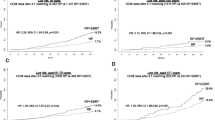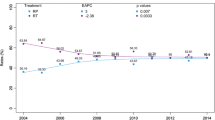Abstract
Purpose
Low-grade prostate cancer has low mortality rates at 10 years; however, it is unclear if the response is sustained for up to 25 years of follow-up.
Methods
Using Surveillance, Epidemiology, and End Results database, the overall and cancer-specific mortality rates were compared among men ≤ 55 years of age diagnosed with low-grade prostate cancer that either had radical prostatectomy, radiotherapy, or no known treatment.
Results
Of the 62,772 men diagnosed with low-grade prostate cancer between 1975 and 2016, about 60%, 20% and 20% of men underwent radical prostatectomy, radiotherapy, and no known treatment, respectively. At a median follow-up of 10 years, almost 2% and 7% of men died of prostate cancer and other causes, respectively. The overall mortality was significantly better in radical prostatectomy group compared to no known treatment group (HR 1.99, CI 1.84–2.15, P value < 0.001), but not between the radiotherapy and no known treatment groups. Moreover, the overall and cancer-specific mortality rates in the radiotherapy group were almost two and three times compared to the radical prostatectomy group, respectively (HR 2.15, CI 2.01–2.29, P value < 0.001 for overall mortality and HR 2.87, CI 2.5–3.29, P value < 0.001 for cancer-specific mortality).
Conclusions
The study confirms low mortality rates in men diagnosed with low-grade prostate cancer for over 25 years’ follow-up. While radical prostatectomy improves survival significantly compared to no known treatment, radiotherapy is associated with an increase in overall and cancer-specific mortality, which may be related to long-term toxicities.


Similar content being viewed by others
References
Ferlay J, Soerjomataram I, Dikshit R et al (2015) Cancer incidence and mortality worldwide: sources, methods and major patterns in GLOBOCAN 2012. Int J Cancer 136(5):E359-386
Siegel RL, Miller KD, Fuchs HE, Jemal A (2021) Cancer statistics, 2021. CA Cancer J Clin 71(1):7–33
Bleyer A, Spreafico F, Barr R (2020) Prostate cancer in young men: an emerging young adult and older adolescent challenge. Cancer 126(1):46–57
SEER Cancer Stat Facts: Prostate Cancer. National Cancer Institute. Bethesda. https://seer.cancer.gov/statfacts/html/prost.html.
Tosoian JJ, Mamawala M, Epstein JI et al (2020) Active surveillance of grade group 1 prostate cancer: long-term outcomes from a large prospective cohort. Eur Urol 77(6):675–682
List of SEER Registries
Howlader N, Ries LA, Mariotto AB, Reichman ME, Ruhl J, Cronin KA (2010) Improved estimates of cancer-specific survival rates from population-based data. J Natl Cancer Inst 102(20):1584–1598
Penson DF, Albertsen PC, Nelson PS, Barry M, Stanford JL (2001) Determining cause of death in prostate cancer: are death certificates valid? J Natl Cancer Inst 93(23):1822–1823
SEER Cause-specific Death Classification
Grossman DC, Curry SJ, Owens DK et al (2018) Screening for prostate cancer: us preventive services task force recommendation statement. JAMA 319(18):1901–1913
Schröder FH, Hugosson J, Roobol MJ et al (2009) Screening and prostate-cancer mortality in a randomized European study. N Engl J Med 360(13):1320–1328
Andriole GL, Crawford ED, Grubb RL 3rd et al (2009) Mortality results from a randomized prostate-cancer screening trial. N Engl J Med 360(13):1310–1319
Albertsen PC (2005) Is screening for prostate cancer with prostate specific antigen an appropriate public health measure? Acta Oncol 44(3):255–264
Carter HB, Partin AW, Walsh PC et al (2012) Gleason score 6 adenocarcinoma: should it be labeled as cancer? J Clin Oncol 30(35):4294–4296
Bryant RJ, Oxley J, Young GJ et al (2020) The ProtecT trial: analysis of the patient cohort, baseline risk stratification and disease progression. BJU Int 125(4):506–514
Hamdy FC, Donovan JL, Lane JA et al (2016) 10-year outcomes after monitoring, surgery, or radiotherapy for localized prostate cancer. N Engl J Med 375(15):1415–1424
Bill-Axelson A, Holmberg L, Ruutu M et al (2011) Radical prostatectomy versus watchful waiting in early prostate cancer. N Engl J Med 364(18):1708–1717
Wilt TJ, Jones KM, Barry MJ et al (2017) Follow-up of prostatectomy versus observation for early prostate cancer. N Engl J Med 377(2):132–142
Klotz L, Vesprini D, Sethukavalan P et al (2015) Long-term follow-up of a large active surveillance cohort of patients with prostate cancer. J Clin Oncol 33(3):272–277
Haffner MC, Mosbruger T, Esopi DM et al (2013) Tracking the clonal origin of lethal prostate cancer. J Clin Invest 123(11):4918–4922
Lange EM, Salinas CA, Zuhlke KA et al (2012) Early onset prostate cancer has a significant genetic component. Prostate 72(2):147–156
Ohri N, Dicker AP, Showalter TN (2012) Late toxicity rates following definitive radiotherapy for prostate cancer. Can J Urol 19(4):6373–6380
Wallis CJ, Mahar AL, Choo R et al (2016) Second malignancies after radiotherapy for prostate cancer: systematic review and meta-analysis. BMJ 352:i851
Mohammed N, Kestin L, Ghilezan M et al (2012) Comparison of acute and late toxicities for three modern high-dose radiation treatment techniques for localized prostate cancer. Int J Radiat Oncol Biol Phys 82(1):204–212
SEER Training module - Morphology and Grade. https://training.seer.cancer.gov/prostate/abstract-code-stage/morphology.html. Accessed 25 Sept 2020
Funding
None.
Author information
Authors and Affiliations
Corresponding author
Ethics declarations
Conflict of interest
No potential conflict of interest.
Ethical approval
This article does not contain any studies with human participants or animals performed by any of the authors.
Additional information
Publisher's Note
Springer Nature remains neutral with regard to jurisdictional claims in published maps and institutional affiliations.
Rights and permissions
Springer Nature or its licensor holds exclusive rights to this article under a publishing agreement with the author(s) or other rightsholder(s); author self-archiving of the accepted manuscript version of this article is solely governed by the terms of such publishing agreement and applicable law.
About this article
Cite this article
Alam, M.U., Kumar, J., Norez, D. et al. Natural history, and impact of surgery and radiation on survival outcomes of men diagnosed with low-grade prostate cancer at ≤ 55 years of age: a 25-year follow-up of > 60,000 men. Int Urol Nephrol 55, 295–300 (2023). https://doi.org/10.1007/s11255-022-03363-6
Received:
Accepted:
Published:
Issue Date:
DOI: https://doi.org/10.1007/s11255-022-03363-6




